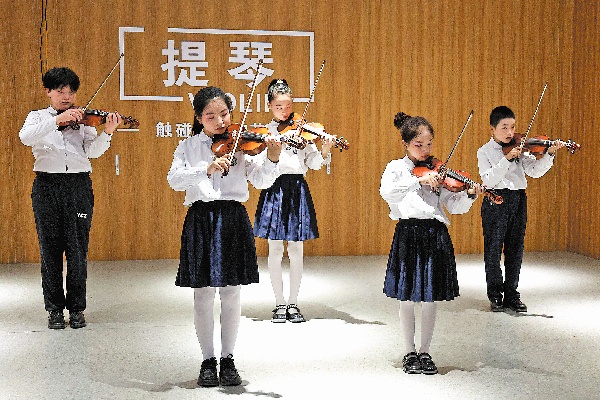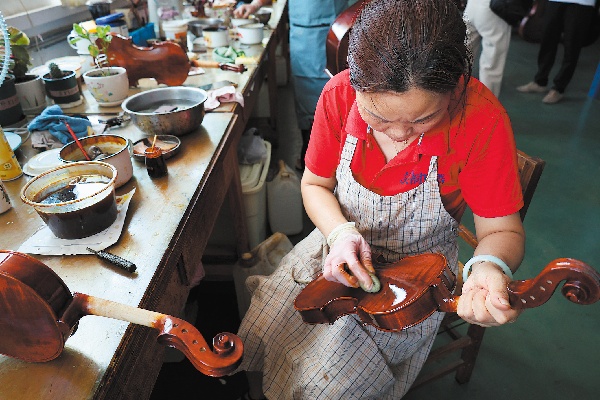
Students perform at Queshan Violin Industrial Park in Queshan county, Zhumadian city, Henan province. [Photo provided to China Daily]
Braving a sweltering summer afternoon in Central China, 12-year-old Chen Yulin steadied her violin beneath her chin. Alongside four classmates, she played My Motherland and I with precision, rehearsing for a school performance marking the 80th anniversary of the victory in the Chinese People's War of Resistance Against Japanese Aggression (1931-45).
The students are from Queshan county in Henan province, once a key stronghold of the Communist Party of China. Leaders including Liu Shaoqi and Li Xiannian, as well as generals like Wang Zhen and Zhang Aiping, trained and fought here. Units of the CPC-led New Fourth Army fanned out from Queshan to resist the aggressors.
Over the past decade, Queshan has waged a different kind of battle: lifting itself out of absolute poverty. Today, the county offers free violin lessons in several public schools — a rarity even in many Chinese cities.
Chen has participated in the program for more than two years, joining 70 classmates receiving professional training and instruments at no cost.
What makes this possible is Queshan's thriving homegrown violin-making industry. According to industry data, 90 percent of the world's violins are made in China, and 80 percent of the country's midto high-end handcrafted violin-family instruments come from Queshan.

A worker polishes a violin at a workshop in the park. [Photo provided to China Daily]
The county now produces over 400,000 violins, violas, cellos and double basses annually, more than 30 percent of China's total output, mostly exported to Europe and North America.
Just above the students' rehearsal room in Queshan Violin Industrial Park, craftsmen cut, carve, sand, and varnish instruments by hand.
"Each violin goes through more than 10 major steps," explains Jiang Hexi, a production supervisor at Haoyun Musical Instruments, one of the park's flagship manufacturers. "From selecting the wood to final tuning, it's all handmade."
Jiang knows the process inside out. In 2001, at 18, he left Queshan to work in a violin-making factory in Beijing, following the path many locals took in search of better income. They learned quickly. After years of painstaking work, Queshan's migrant workers mastered the craft that originated in 16thcentury Italy.
"The hands that once held farming tools now produce world-class violins," he says.
In 2015, Jiang returned, drawn by a local initiative to boost the industry. The county provided land, rent-free factory space, tax breaks, and streamlined permits. From a handful of workshops, the sector has grown into 144 manufacturers and a complete supply chain, from raw material processing to final tuning.
Haoyun, where Jiang now works, alone employs over 200 local villagers, paying far more than traditional farming. Annual output is valued around 600 million yuan ($82 million).
Zang Yuxia, a local official, notes that Queshan's transformation is built on a deeper foundation. Her 96-year-old father once served in the New Fourth Army and fought against Japanese aggression in Queshan in the 1940s.
Having grown up with stories of resistance and seen her hometown transform, Zang says, "Back then, the people of Queshan fought for independence with guns. Today, we're building the future with violins."
The violin industry has reshaped both economy and culture. Queshan is no longer just a place that makes violins; it's becoming a place where the instrument's melodic strings also echo. Children with instrument cases are a common sight after school, and violin-shaped streetlamps line roads outside music schools.
"Developing our own brand, offering high-end custom instruments, and training luthiers with strong musical backgrounds is the future of Queshan's violin-making industry," says Guo Xinshe, Haoyun's general manager.
Haoyun's early support for the government-backed free training program launched in 2023 provides instruments to students, including Chen and her classmates. Weekly classes begin from second grade, with plans to expand to first-graders.
Jiang is heartened to see more children in Queshan picking up the instrument. For the past eight years, he has driven his son to Zhumadian — the prefecture-level city that administers Queshan — every weekend for violin lessons. Now 15, his son has already reached Grade 8 proficiency in the exams of the Central Conservatory of Music, one of China's most prestigious music academies.
"I've worked with violins my entire adult life, yet I can't play a single note," he says. "I hope this instrument becomes something more for the next generation, a part of their lives and not just a way to make a living."


